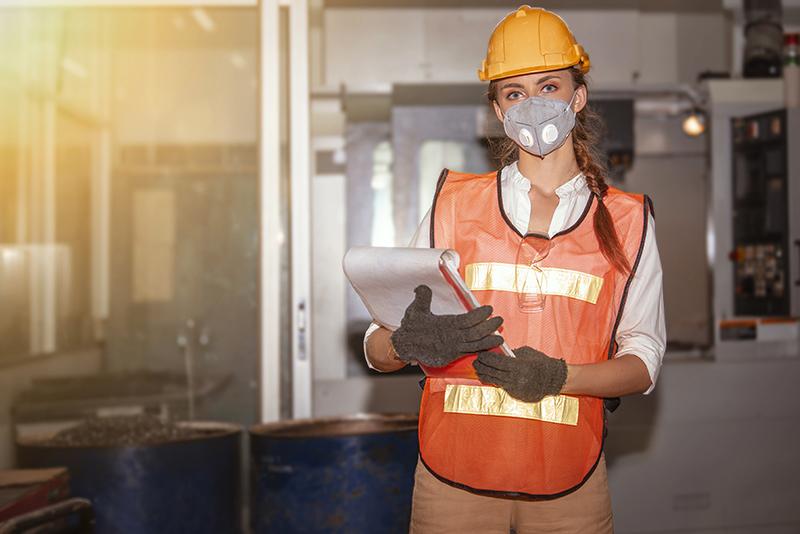Health and safety considerations for manufacturers during COVID-19
Manufacturers can institute measures to contain the coronavirus by identifying individuals who might be infected; prevent spread by instituting social distancing and other safety policies, and cleaning work areas; and comply with privacy protections to protect employee identities. Below are some top tips.

This article is the second in the NGA’s series on Reopening the Workplace. While many manufacturing facilities were allowed to stay open as essential businesses during the initial COVID-19 outbreak beginning in March, companies have had to institute new procedures and operations in an effort to prevent the spread of coronavirus.
Since COVID-19, “something has fundamentally and irrevocably changed for manufacturers. How manufacturers think about operations, what they make and how. Concerns over safety, flexibility, agility,” says David Brousell, executive director, manufacturing leadership for the National Association of Manufacturers.
During a recent NAM webinar, several expert panelists offered tips to manufacturers as they institute health and safety protocols at their plant facilities. The panelists included Carolyn Lee, executive director of The Manufacturing Institute; Danny Smith, vice president, industry advisory and principal, Industrial Sectors, Ceridian; and Mark Jules, global vice president, Smart Spaces and Video Intelligence, Hitachi.
“We look at the current situation in three ways: containment, prevention, compliance,” says Jules. Manufacturers can institute measures to contain the virus by identifying individuals who might be infected; prevent spread by instituting social distancing and other safety policies, and cleaning work areas; and comply with privacy protections to protect employee identities. Below are some top tips from the panelists.
Coronavirus prevention at the factory
Screen employees
Preventing spread of the coronavirus at a factory begins at the front door, say panelists. They recommend manufacturers limit points of entry and conduct temperature screening of everyone entering a facility. Some manufacturers are also using thermal imagers in other areas of the plant to identify people with elevated temperatures.
Employees with elevated temperatures should “go through secondary testing and, if need be, be sent home, and proper action be taken based on where they have been,” Jules says.
Protect employee privacy
With any screening procedures, manufacturers must ensure they are complying with privacy requirements. Jules recommends companies use tools that do not identify individuals, particularly if data is being shared with outside parties. He also notes that managers should communicate tracking and screening procedures before they are instituted. “Start with education. This is what we are doing and why we are doing it,” he says.
Provide PPE
Companies must ensure employees have access to proper safety gear. “PPE will be a fixture in everybody’s day-to-day life and operations for quite some time,” says Lee. “The level of protection will depend on your company’s normal level of protection and what the products are that you’re making. PPE will be an essential part of response and recovery.”
Adjust shift schedules
Manufacturers should consider making shift changes to limit the number of employees onsite at any given time. One solution is no crossover shifts, “so that the first shift doesn’t interact with the second shift. The first group clears out before the next group comes in,” says Lee.
Many manufacturers are also adding flexibility to shift schedules to better accommodate worker needs. “Companies are providing flexibility where possible so employees can take care of families, take care of children at home, with schools closed,” Lee says.
To reduce the number of employees in break rooms and eating areas, manufacturers should rotate break times, says Lee. Companies can also consider providing access to additional areas in the facility to ensure workers are able to maintain safe social distance.
Educate and train
Employees must be educated about new safety and health protocols. “Over-invest in communications right now,” says Ceridian’s Smith. Since in-person group meetings are no longer possible, Smith recommends employers use video. “Videos can be highly effective,” he says.
Go touchless
Many manufacturers are moving to touchless access, including for clock-ins, says Smith. “We have seen a 500 percent increase in customers switching from physical clock punch to offering mobile phone clock-in,” he says. He has also seen an increase in the use of audio assistance features throughout plants as companies move to “de-touch the value chain.”
Add markings and barriers
Manufacturers should provide floor markings to indicate safe social distances at workstations. Transparent barriers can be added to provide additional separation.
Perform thorough and frequent cleanings
Facilities must be cleaned regularly, with a focus on regularly touched surfaces. Some manufacturers are instituting more rigorous cleaning measures, such as providing additional air filtration and adding UV lighting. “We’ve also heard discussion of using copper fixtures, as copper has naturally resistant features for viruses,” says Smith.
Add automation
The automated manufacturing trend has accelerated in the time of COVID-19, says Smith. The market has seen an uptick in the use of partial automation, in particular the use of cobots—robots that function alongside humans. “If we need to do social distancing, cobots provide a way to help humans and to spread workers out,” he says.
Provide essential worker documentation
In states that maintain stay-at-home orders, workers may require documentation indicating they are essential workers. “Provide employees with letters to show they are essential, so they are able to be in transit,” says Lee.